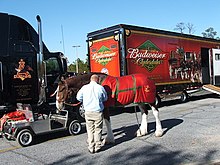Tack is equipment or accessories equipped on horses and other equines in the course of their use as domesticated animals. This equipment includes such items as saddles, stirrups, bridles, halters, reins, bits, and harnesses. Equipping a horse is often referred to as tacking up. A room to store such equipment, usually near or in a stable, is a tack room.

A spraydeck is a flexible waterproof cover for a boat with holes for the passengers' waists. Spraydecks are used to prevent water from entering the boat while allowing passengers to paddle or row.

A bridle is a piece of equipment used to direct a horse. As defined in the Oxford English Dictionary, the "bridle" includes both the headstall that holds a bit that goes in the mouth of a horse, and the reins that are attached to the bit.

The blanket sleeper is a type of especially warm sleeper or footie pajama worn primarily during the winter in the United States and Canada. The garment is worn especially by young children.
Oilskin is a waterproof cloth used for making garments typically worn by sailors and by others in wet areas. The modern oilskin garment was developed by a New Zealander, Edward Le Roy, in 1898. Le Roy used worn-out sailcloth painted with a mixture of linseed oil and wax to produce a waterproof garment suitable to be worn on deck in foul-weather conditions. Oilskins are part of the range of protective clothing also known as foul weather gear.
A martingale is any of several designs of tack that are used on horses to control head carriage. Martingales may be seen in a wide variety of equestrian disciplines, both riding and driving. Rules for their use vary widely; in some disciplines they are never used, others allow them for schooling but not in judged performance, and some organizations allow certain designs in competition.

A girth, sometimes called a cinch, is a piece of equipment used to keep the saddle in place on a horse or other animal. It passes under the barrel of the equine, usually attached to the saddle on both sides by two or three leather straps called billets. Girths are used on Australian and English saddles, while western saddles and many pack saddles have a cinch, which is fastened to the saddle by a single wide leather strap on each side, called a latigo.
There are many aspects to horse management. Horses, ponies, mules, donkeys and other domesticated equids require attention from humans for optimal health and long life.
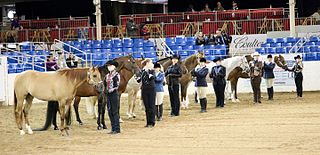
Showmanship is an event found at many horse shows. The class is also sometimes called "Fitting and Showmanship", "Showmanship In-Hand", "Showmanship at Halter" or "Halter Showmanship" It involves a person on the ground leading a horse, wearing a halter or bridle, through a series of maneuvers called a pattern. The horse itself is not judged on its conformation. Exhibitors are judged on exhibiting the animal to its best advantage, with additional scoring for the grooming and presentation of both horse and handler.
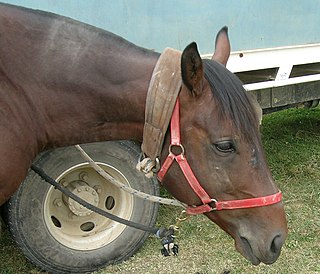
An animal collar is a device that attaches to the neck of an animal to allow it to be harnessed or restrained.
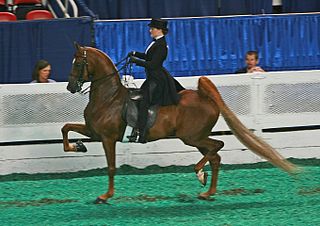
Saddle seat is a style of horse riding within the category of English riding that is designed to show off the high action of certain horse breeds. The style developed into its modern form in the United States, and is also seen in Canada and South Africa. To a much lesser extent, it is ridden with American horse breeds in Europe and Australia.
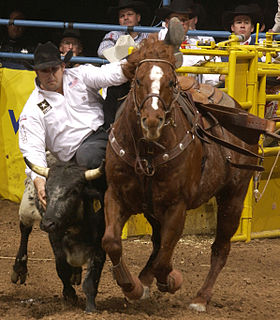
A breastplate is a piece of riding equipment used on horses. Its purpose is to keep the saddle or harness from sliding back.

The saddle is a supportive structure for a rider of an animal, fastened to an animal's back by a girth. The most common type is equestrian. However, specialized saddles have been created for oxen, camels and other animals. It is not known precisely when riders first began to use some sort of padding or protection, but a blanket attached by some form of surcingle or girth was probably the first "saddle", followed later by more elaborate padded designs. The solid saddle tree was a later invention, and though early stirrup designs predated the invention of the solid tree, the paired stirrup, which attached to the tree, was the last element of the saddle to reach the basic form that is still used today. Today, modern saddles come in a wide variety of styles, each designed for a specific equestrianism discipline, and require careful fit to both the rider and the horse. Proper saddle care can extend the useful life of a saddle, often for decades. The saddle was a crucial step in the increased use of domesticated animals, during the Classical Era.

Markings on horses are usually distinctive white areas on an otherwise dark base coat color. Most horses have some markings, and they help to identify the horse as a unique individual. Markings are present at birth and do not change over the course of the horse's life. Most markings have pink skin underneath most of the white hairs, though a few faint markings may occasionally have white hair with no underlying pink skin. Markings may appear to change slightly when a horse grows or sheds its winter coat, however this difference is simply a factor of hair coat length; the underlying pattern does not change.
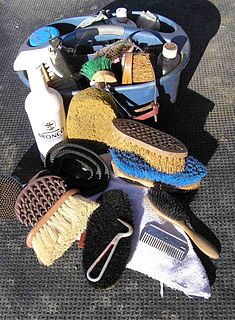
Horse grooming is hygienic care given to a horse, or a process by which the horse's physical appearance is enhanced for horse shows or other types of competition.
Horse harness is a device that connects a horse to a vehicle or another type of load.

This is a basic glossary of equestrian terms that includes both technical terminology and jargon developed over the centuries for horses and other equidae, as well as various horse-related concepts. Where noted, some terms are used only in American English (US), only in British English (UK), or are regional to a particular part of the world, such as Australia (AU).

The tail of the horse and other equines consists of two parts, the dock and the skirt. The dock consists of the muscles and skin covering the coccygeal vertebrae. The term "skirt" refers to the long hairs that fall below the dock. On a horse, long, thick tail hairs begin to grow at the base of the tail, and grow along the top and sides of the dock. In donkeys and other members of Equus asinus, as well as some mules, the zebra and the wild Przewalski's horse, the dock has short hair at the top of the dock, with longer, coarser skirt hairs beginning to grow only toward the bottom of the dock. Hair does not grow at all on the underside of the dock.
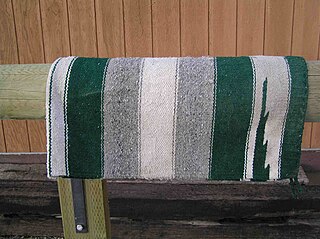
The terms saddle blanket, saddle pad, and saddle cloth refer to blankets, pads or fabrics inserted under a saddle. These are usually used to absorb sweat, cushion the saddle, and protect the horse's back. There are lighter types of saddle cloth, such as the shabrack, used primarily for decorative purposes, often placed over the top of a more utilitarian pad.
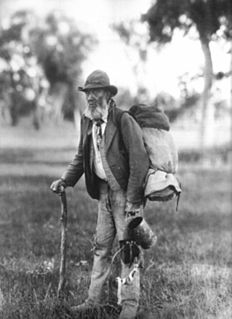
The cowboy bedroll was an American Old West precursor to the modern sleeping bag, which carried a man's bed and some personal belongings in a waterproof shell. In Australia, it was called a swag.

